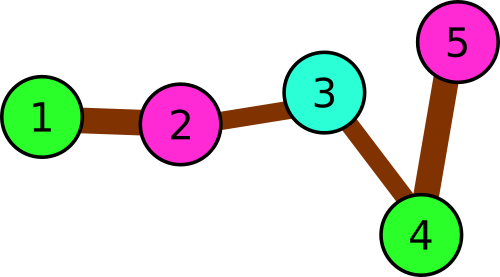Codeforces 782C Andryusha and Colored Balloons【思维+Dfs暴力染色】
来源:互联网 发布:韩国东大门代购淘宝店 编辑:程序博客网 时间:2024/06/05 17:39
Andryusha goes through a park each day. The squares and paths between them look boring to Andryusha, so he decided to decorate them.
The park consists of n squares connected with(n - 1) bidirectional paths in such a way that any square is reachable from any other using these paths. Andryusha decided to hang a colored balloon at each of the squares. The baloons' colors are described by positive integers, starting from 1. In order to make the park varicolored, Andryusha wants to choose the colors in a special way. More precisely, he wants to use such colors that ifa, b andc are distinct squares that a and b have a direct path between them, andb and c have a direct path between them, then balloon colors on these three squares are distinct.
Andryusha wants to use as little different colors as possible. Help him to choose the colors!
The first line contains single integer n (3 ≤ n ≤ 2·105) — the number of squares in the park.
Each of the next (n - 1) lines contains two integersx and y (1 ≤ x, y ≤ n) — the indices of two squares directly connected by a path.
It is guaranteed that any square is reachable from any other using the paths.
In the first line print single integer k — the minimum number of colors Andryusha has to use.
In the second line print n integers, thei-th of them should be equal to the balloon color on thei-th square. Each of these numbers should be within range from1 to k.
32 31 3
31 3 2
52 35 34 31 3
51 3 2 5 4
52 13 24 35 4
31 2 3 1 2
In the first sample the park consists of three squares: 1 → 3 → 2. Thus, the balloon colors have to be distinct.
 Illustration for the first sample.
Illustration for the first sample. In the second example there are following triples of consequently connected squares:
- 1 → 3 → 2
- 1 → 3 → 4
- 1 → 3 → 5
- 2 → 3 → 4
- 2 → 3 → 5
- 4 → 3 → 5
 Illustration for the second sample.
Illustration for the second sample. In the third example there are following triples:
- 1 → 2 → 3
- 2 → 3 → 4
- 3 → 4 → 5
 Illustration for the third sample.
Illustration for the third sample.题目大意:
给你N个点,有N-1条边,构成一棵树,要求任意一条长度为2的链(包含三个点)中的三个点,颜色都不能相同。
问最少需要几种颜色就足够了,并且要求输出一种可行解。
思路:
显然,max(degree【i】)+1就是需要的最少颜色个数。
那么接下来我们只要随便Dfs染染色就行了。
#include<stdio.h>#include<string.h>#include<vector>using namespace std;vector<int >mp[300050];int color[300050];int degree[300050];int ans;void Dfs(int u,int from){ int tmp=1; for(int i=0;i<mp[u].size();i++) { int v=mp[u][i]; if(v==from)continue; else { for(int j=tmp;j<=ans;j++) { if(j!=color[u]) { if(from==-1) { color[v]=j; tmp=j+1; break; } else if(j!=color[from]) { color[v]=j; tmp=j+1; break; } } } Dfs(v,u); } }}int main(){ int n; while(~scanf("%d",&n)) { for(int i=1;i<=n;i++)mp[i].clear(); memset(degree,0,sizeof(degree)); for(int i=0;i<n-1;i++) { int x,y; scanf("%d%d",&x,&y); mp[x].push_back(y); mp[y].push_back(x); degree[x]++; degree[y]++; } ans=0; for(int i=1;i<=n;i++)ans=max(ans,degree[i]); ans++; printf("%d\n",ans); color[1]=1; Dfs(1,-1); for(int i=1;i<=n;i++) { printf("%d ",color[i]); } printf("\n"); }}- Codeforces 782C Andryusha and Colored Balloons【思维+Dfs暴力染色】
- Codeforces 782C Andryusha and Colored Balloons dfs
- 【codeforces 782C】Andryusha and Colored Balloons
- codeforces 782c Andryusha and Colored Balloons
- Codeforces Round #403 C. Andryusha and Colored Balloons(DFS)
- Codeforces 780C Andryusha and Colored Balloons 搜索dfs
- CodeForces 780C Andryusha and Colored Balloons【DFS】
- codeforces 780-C. Andryusha and Colored Balloons(dfs)
- Codeforces 780C-Andryusha and Colored Balloons dfs
- Codeforces 780C-Andryusha and Colored Balloons
- Codeforces 782C Andryusha and Colored Balloons(BFS)
- codeforces 782C Andryusha and Colored Balloons【构造】
- Codeforces Andryusha and Colored Balloons
- cf 782c Andryusha and Colored Balloons
- C. Andryusha and Colored Balloons
- C. Andryusha and Colored Balloons
- C. Andryusha and Colored Balloons
- codeforces 781A Andryusha and Colored Balloons(树上dfs)
- 【error】intellij idea:Unable to save settings
- 蓝桥杯 ADV-71 算法提高 判断回文
- mysql 索引
- datatable设置成中文
- 蓝桥杯 ADV-72 算法提高 一元一次方程
- Codeforces 782C Andryusha and Colored Balloons【思维+Dfs暴力染色】
- Android锁屏后调用了ondestroy()方法,解屏后重新oncreate()的问题的解决方案。
- $uibModal
- 蓝桥杯 ADV-73 算法提高 数组输出
- #Error:No cached version of com.android.tools:annotations:25.2.3 available for offline mode.
- sdagfafd
- sketch中制作蒙版及通道蒙版
- 软件架构师实战
- spring boot集成dubbo


